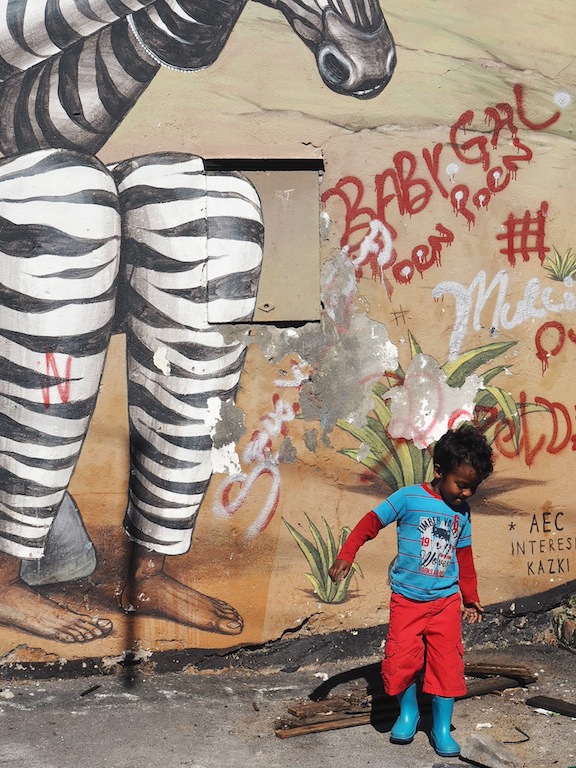“The section on the right,” Juma explained, “represents the women who protested the Pass Laws of Apartheid, whilst the faces on the left belong to the students of Soweto who rose up when it was declared that schooling would take place strictly in Afrikaans.”
This important lesson about the events that helped dismantle Apartheid in South Africa is taking place in a Cape Town car park. The powerful monochrome mural that Juma, our guide, is explaining belongs to a wall in Woodstock and was created by artist Freddy Sam who seeks to inspire social change through art.


Freddy is one of approximately 40 artists who have painted murals with messages on the streets of Woodstock. They’ve created an outdoor gallery covering important subjects such as social change and wildlife conservation and it’s open for all to see.
“This way everyone owns the art”, says Juma.


Juma has lived in Woodstock since 2009 and during that time has seen how the artwork has helped shape the thriving creative industry that is found here today. At the heart of Woodstock’s regeneration is The Woodstock Exchange, a collection of media offices, boutiques, workshops and trendy cafes, which is itself dotted with sculptures and murals made by the local artists.

In recent years, coffee roasters including Tribe and acclaimed restaurants such as The Pot Luck Club have also opened in the area, making Woodstock one of the trendiest suburbs in Cape Town.
To help visitors understand the messages behind the art, as well as the people whose homes the artwork decorate, Juma runs street art walking tours of Woodstock. In peak season this tours run 4 times a day – the artists who wanted to paint life back into these streets have succeeded.



Artists and entrepreneurs are spearheading the regeneration of urban areas in Johannesburg too. Maboneng, in inner city Joburg, is a neighbourhood of galleries, cafes, co-working spaces, residential apartments and tourist accommodation that is bound together by art. This thriving community, self-described as the epicenter of the Joburg inner-city renaissance, is watched over by larger-than-life murals of Mandela who fought for the change that is embodied by Maboneng.

 In nearby Braamfontein, cooks, designers and coffee roasters gather every Saturday to sell their artisan products to the students who live in the area and tourists like myself who would not have ventured to this part of town just a few years ago. The Neighbourgoods Market has transformed a dilapidated neighbourhood into a hot destination and a 15-story wall mural by the famed artist Eduardo Villa signals you have found it.
In nearby Braamfontein, cooks, designers and coffee roasters gather every Saturday to sell their artisan products to the students who live in the area and tourists like myself who would not have ventured to this part of town just a few years ago. The Neighbourgoods Market has transformed a dilapidated neighbourhood into a hot destination and a 15-story wall mural by the famed artist Eduardo Villa signals you have found it.


Street art is created to inspire social change all over the world but never have I seen it have such a direct impact on society than in the new South Africa.
More Info
I visited South Africa for the annual gathering of the Australian Society Of Travel Writers. My trip was supported by South Africa Tourism Australia, all opinions are my own.
To book a street art walking tour of Woodstock contact Juma directly on [email protected] or +27734004064. Find more details here.
Read next:


1 thought on “Street Art And Social Change In South Africa”